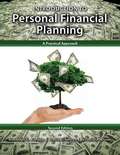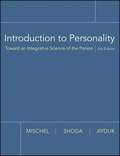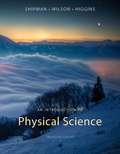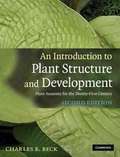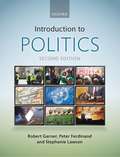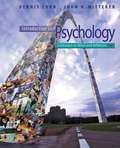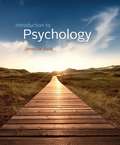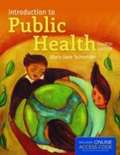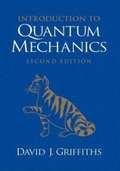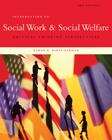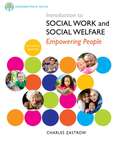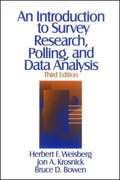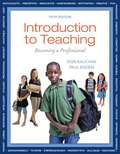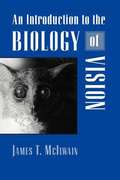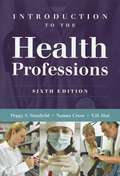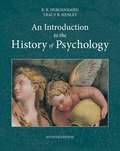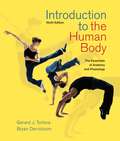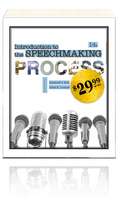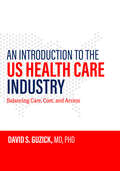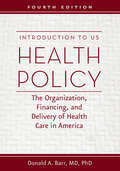- Table View
- List View
Introduction to Personal Financial Planning: A Practical Approach
by David B. Stewart Alexander G. Kondeas Nicholas A. DavesA practical approach to introduction to personal financial planing
Introduction to Personality: Toward an Integrative Science of the Person
by Walter Mischel Yuichi Shoda Ozlem AydukReflecting the latest developments, this eighth edition paints a picture of the field as a cumulative, integrative science that builds on its rich past. It provides a much more coherent view of the whole functioning individual in the social world. Throughout the chapters, emphasis is placed on practical applications and personal relevance to everyday life in a clear and compelling way. The book also explores the essential features and contributions from the field's heritage
An Introduction to Physical Science (13th Edition)
by James Shipman Jerry D. Wilson Aaron Todd Charles A. HigginsConsistent with previous editions of An Introduction to Physical Science, the goal of the new Thirteenth edition is to stimulate students' interest in and gain knowledge of the physical sciences. Presenting content in such a way that students develop the critical reasoning and problem-solving skills that are needed in an ever-changing technological world, the authors emphasize fundamental concepts as they progress through the five divisions of physical sciences: physics, chemistry, astronomy, meteorology, and geology. Ideal for a non-science majors course, topics are treated both descriptively and quantitatively, providing instructors the flexibility to emphasize an approach that works best for their students.
An Introduction to Plant Structure and Development
by Charles B. BeckA plant anatomy textbook unlike any other on the market today. Carol A. Peterson described the first edition as 'the best book on the subject of plant anatomy since the texts of Esau'. Traditional plant anatomy texts include primarily descriptive aspects of structure, this book not only provides a comprehensive coverage of plant structure, but also introduces aspects of the mechanisms of development, especially the genetic and hormonal controls, and the roles of plasmodesmata and the cytoskeleton. The evolution of plant structure and the relationship between structure and function are also discussed throughout. Includes extensive bibliographies at the end of each chapter. It provides students with an introduction to many of the exciting, contemporary areas at the forefront of research in the development of plant structure and prepares them for future roles in teaching and research in plant anatomy.
An Introduction to Politics
by T. M. SellThis textbook introduces students to the field of Political Studies. An Introduction to Politics is a little more brief, concise and in-between than similar textbooks currently on the market. Because this is usually a first-year course, overloading a textbook with too much minutiae of the ins and outs of politics can lead to students giving up on the book. Politics is a great story - the story of human existence. A successful textbook needs to tell that story.
Introduction to Politics (Second Edition)
by Robert Garner Peter Ferdinand Stephanie LawsonIntroduction to Politics, Second Edition, provides an intellectually stimulating yet accessible introduction to politics that takes current global realities into account. The text is divided into three sections that reflect the authors' expertise: concepts and ideologies, comparative politics, and international relations.
Introduction to Psychology: Gateways to Mind and Behavior (Thirteenth Edition)
by Dennis Coon John O. MittererCo-written by an author who garners more accolades and rave reviews from instructors and students with each succeeding edition, INTRODUCTION TO PSYCHOLOGY: GATEWAYS TO MIND AND BEHAVIOR, THIRTEENTH EDITION attracts and holds the attention of even difficult-to-reach students. The Thirteenth Edition's hallmark continues to be its pioneering integration of the proven-effective SQ4R learning system (Survey, Question, Read, Reflect, Review, Recite), which promotes critical thinking as it guides students step-by-step to an understanding of psychology's broad concepts and diversity of topics. Throughout every chapter, these active learning tools, together with the book's example-laced writing style, discussions of positive psychology, cutting-edge coverage of the field's new research findings, and excellent media resources, ensure that users find the study of psychology fascinating, relevant, and above all, accessible.
Introduction to Psychology
by Charles StangorWhen you teach Introduction to Psychology, do you find it difficult -- much harder than teaching classes in statistics or research methods? Do you easily give a lecture on the sympathetic nervous system, a lecture on Piaget, and a lecture on social cognition, but struggle with linking these topics together for the student? Do you feel like you are presenting a laundry list of research findings rather than an integrated set of principles and knowledge? Have you wondered how to ensure your course is relevant to your students? If so, then you have something in common with Charles Stangor. Charles Stangor's Introduction to Psychology utilizes the dual theme of behavior and empiricism to make psychology relevant to intro students. Charles wrote this book to help students organize their thinking about psychology at a conceptual level. Five or ten years from now, he does not expect his students to remember the details of most of what he teaches them.
Introduction to Psychology (8th edition)
by James W. KalatFocusing on one type of behavior at a time, this textbook examines the roles biology, learning experiences, and social influences play in human intelligence, memory, perception, states of consciousness, cognition, motivation, and personality. The eighth edition updates references and adds sections on synesthesia, procrastination, and decision making. Annotation ©2007 Book News, Inc., Portland, OR (booknews.com)
Introduction to Psychology (Tenth Edition)
by James W. KalatJames Kalat's best-selling INTRODUCTION TO PSYCHOLOGY does far more than cover major theories and studies; it encourages you to question the information and ask yourself, "How was this conclusion reached?" and "Does the evidence really support it?" In this student-praised text, Kalat challenges your preconceptions about psychology to help you become a more informed consumer of information not only during your college experience but also as you venture into your post-college life. With his humorous writing style and hands-on "Try It Yourself" exercises, Kalat puts you at ease and gets you involved with what you are studying so that you can succeed in your course.
Introduction to Psychology, Version 2.0
by Charles StangorCharles Stangor's Introduction to Psychology utilizes the dual theme of behavior and empiricism to make psychology relevant to intro students.
Introduction To Public Health 4th Edition
by Mary-Jane SchneiderIntroduction to Public Health, Fourth Edition offers a thorough, accessible overview of the expanding field of public health for students new to its concepts and actors. Written in engaging, nontechnical language, this best-selling text explains in clear terms the multi-disciplinary strategies and methods used for measuring, assessing, and promoting public health. Packed with illustrative real-world examples, this updated edition provides students with informative discussions of the current technical issues and practical obstacles facing public health practitioners and policymakers alike. Through coverage of new approaches to research and data collection, current best practices in the field, and the social and ethical challenges of devising public policy, Introduction to Public Health, Fourth Edition provides readers with a broad-reaching, practical framework for understanding the multifaceted forces and organizations of today's public health enterprise.
Introduction to Quantum Mechanics
by David J. GriffithsFundamental principles are covered, quantum theory presented, and special techniques developed for attacking realistic problems. The book s two-part coverage organizes topics under basic theory, and assembles an arsenal of approximation schemes with illustrative applications. For physicists and engineers.
Introduction to Social Work and Social Welfare: Critical Thinking Perspectives
by Karen K. Kirst-AshmanINTRODUCTION TO SOCIAL WORK & SOCIAL WELFARE: CRITICAL THINKING PERSPECTIVES, 3E gives students who are contemplating a career in social work a solid introduction to the profession. Using clear, engaging prose, author Kirst-Ashman presents a balanced, introductory look within a unifying theme of critical thinking that trains students to be more evaluative of key concepts. The topics covered include practice concepts, social welfare policy concepts, history and current state of the profession, the contexts of practice and populations served, and student development.
Introduction To Social Work And Social Welfare
by Charles ZastrowThe bestselling introductory Social Work book on the market, Zastrow's INTRODUCTION TO SOCIAL WORK AND SOCIAL WELFARE: EMPOWERING PEOPLE, 11th Edition, is also lauded for being the most comprehensive. In addition to giving readers a thorough overview of the social work profession, this text offers a realistic view of social problems in contemporary society, equipping students with real-world insight that they can apply in practice. By presenting positive strategies in the context of the core values, ethics, skills, and knowledge base of today's professional social worker, Zastrow encourages readers to think critically about new, workable methods for problem-solving and empowering clients. Contemporary social problems case studies, exhibits, and tables help users apply concepts and compare and contrast issues. The Eleventh Edition has been thoroughly updated to include the latest NASW Standards, as well as new and emerging issues from the field. Packed with cutting-edge coverage and comprehensive CSWE core content, INTRODUCTION TO SOCIAL WORK AND SOCIAL WELFARE: EMPOWERING PEOPLE, 11th Edition, continues to inspire readers while giving them insight into real-world practice.
Introduction to Sociology (Fifth Edition)
by Laurence A. Bastirico Barbara G. Cashion J. Ross EshlemenIntroductory college textbook on sociology
An Introduction to Survey Research, Polling, and Data Analysis (3rd edition)
by Herbert F. Weisberg Jon A. Krosnick Bruce D. BowenExplains how surveys are conducted, how to read statistical reports, and how to analyze data, and provides guidelines for evaluating polls. Coverage includes understanding tables, interval statistics, survey design, sampling and question-writing, interviewing and coding strategies, analysis of different types of surveys, and reading and writing reports. Includes chapter exercises and answers. Paper edition (unseen), $25. 95. Annotation c. by Book News, Inc. , Portland, Or.
Introduction to Teaching: Becoming a Professional (Fifth Edition)
by Don Kauchak Paul EggenThe best-selling case-based text, Introduction to Teaching: Becoming a Professional, sharpens its focus on issues in education in its Fifth Edition. Weaving this focus throughout every chapter with new features and chapter sections covering diversity, reform, urban education, and technology, the text ensures that prospective teachers gather all the needed information to create an up-to-date picture of the ever changing face of education. The authors take this information and bring it to life with cases, classroom examples and videos, again ensuring that the living, changing, challenging and fulfilling life of an educator is as clear as it can be.
An Introduction to the Biology of Vision
by James T. McilwainThis textbook is intended for use in a course for undergraduate students in biology, neuroscience or psychology who have had an introductory course on the structure and function of the nervous system. Its primary purpose is to provide a working vocabulary and knowledge of the biology of vision and to acquaint students with the major themes in biological vision research. Part I treats the eye as an image-forming organ and provides an overview of the projections from the retina to key visual structures of the brain. Part II examines the functions of the retina and its central projections in greater detail, building on the introductory material of Part I. Part III treats certain special topics in vision that require this detailed knowledge of the structure and properties of the retina and visual projections.
Introduction to the Health Professions (Sixth Edition)
by Peggy S. Stanfield Y. H. Hui Nanna CrossCompletely updated, Introduction to the Health Professions, Sixth Edition provides the most current, comprehensive coverage of all the major health professions. This popular text outlines more than 75 careers and touches on every major facet of the field including training requirements, job responsibilities, and salaries. This fundamental resource provides a thorough review of the U. S. healthcare delivery system, managed care, health care financing, reimbursement, insurance coverage, Medicare, Medicaid, and the impact of new technology on healthcare services. Written specifically for students who plan to become healthcare professionals, this text will give you all the information you need for a successful career! New Topics and Updates in the Sixth Edition Historical review of the health insurance industry in the United States Expanded discussion of public health care--Medicaid, Medicare, and Children's Health Insurance Program (CHIP)New section on healthcare reform due to the Patient Protection and Affordable Care Act of 2010Up-to-date coverage of individual states' implementation of healthcare reform Future-looking perspective on the evolving roles and responsibilities in health careers and the impact of future demographic and socioeconomic changes on healthcare needs Useful information on educational grants and loan repayment programs Current data for each profession from the latest Occupational Outlook (U. S. Department of Labor, 2010 - 2011)New chapter with current information on athletic trainers Instructor Resources: Transition Guide, Instructor's Manual, PowerPoint Presentations, and a Test Bank. Student Resources: Companion Website Instructors: Bundle this product with additional Jones & Bartlett introductory health professions texts and save your students up to 30% off list price. Contact your Account Specialist for more information.
An Introduction to the History of Psychology
by B. R. Hergenhahn Tracy HenleyDreams puzzled early man, Greek philosophers spun elaborate theories to explain human memory and perception, Descartes postulated that the brain was filled with "animal spirits," and psychology was officially deemed a "science" in the 19th century. In this Seventh Edition of AN INTRODUCTION TO THE HISTORY OF PSYCHOLOGY, authors Hergenhahn and Henley demonstrate that most of the concerns of contemporary psychologists are manifestations of themes that have been part of psychology for hundreds--or even thousands--of years. The book's numerous photographs and pedagogical devices, along with its biographical material on key figures in psychology, engage readers and facilitate their understanding of each chapter. Available with InfoTrac Student Collections http://gocengage. com/infotrac.
Introduction to the Human Body (Ninth Edition)
by Gerard J. Tortora Bryan H. DerricksonThe 9th edition of Tortora's "Introduction to the Human Body 8e" provides basic content, focused design, and relevant connections about the essentials of anatomy and physiology. All chapters are focused on the essential structure and functions of the human body needed for a basic understanding of homeostasis. The concise narrative is paired with outstanding illustrations, many newly revised for this edition, that help keep readers fully engaged with the topic at hand. Dynamic animations of key physiological processes as well as interactive anatomy reviews are fully integrated when the content is introduced in WileyPLUS. The new edition also features fully updated Clinical Connections that provide relevance to help understand what happens when homeostasis is disrupted, and providing insights into the content and knowledge to come in their allied health curriculum. The popular feature - Focus on Wellness - is completely updated with new content and topics. A pedagogical design is reflected in both printed text and WileyPLUS and clear learning objectives along with checkpoint questions for practice and review bookend each focused section of content within a chapter.
Introduction to the Speechmaking Process (Fourteenth Edition)
by Raymond S. Ross Diana K. LeonardGood communicators are almost always knowledgeable in the critical areas of the communication process, perception, language, logical thinking, and presentation. The Speechmaking Process addresses all of these important areas and relates them eclectically to effective and responsible public speaking. The book helps students become effective critical thinkers, language users, organizers, and ethical purveyors of informative and persuasive messages.
An Introduction to the US Health Care Industry: Balancing Care, Cost, and Access
by David S. GuzickWhy does US health care have such high costs and poor outcomes? Dr. David S. Guzick offers this critique of the American health care industry and argues that it could work more effectively by rebalancing care, cost, and access.For decades, the United States has been faced with a puzzling problem: Despite spending much more money per capita on health care than any other developed nation, its population suffers from notoriously poorer health. In comparison with 10 other high-income nations, in fact, the US has the lowest life expectancy at birth, the highest rates of infant and neonatal mortality, and the most inequitable access to physicians when adjusted for need. In An Introduction to the US Health Care Industry, Dr. David S. Guzick takes an in-depth look at this troubling issue. Bringing to bear his unique background as a physician, economist, former University of Rochester medical school dean, and former president of the University of Florida Health System, Dr. Guzick shows that what we commonly refer to as the US health care "system" is actually an industry forged by a unique collection of self-interested and disjointed stakeholders. He argues that the assumptions underlying well-functioning markets do not align with health care. The resulting market imperfections, combined with entrenched industry stakeholders, have led to a significant imbalance of care, cost, and access.Using a nontechnical framework, Dr. Guzick introduces readers to the economic principles behind the function—and dysfunction—of our health care industry. He shows how the market-based approach could be expected to remedy these problems while detailing the realities of imperfections, regulations, and wealth inequality on those functions. He also analyzes how this industry developed, presenting the conceptual underpinnings of the health care industry while detailing its history and tracing the creation and entrenchment of the current federation of key stakeholders—government, insurance companies, hospitals, doctors, employers, and drug and device manufacturers. In the final section of the book, Dr. Guzick looks to the future, describing the prevention, innovation, and alternative financing models that could help to rebalance the priorities of care, cost, and access that Americans need.An online supplement on COVID-19 is available, as is a discussion guide for instructors. To access this supplemental material, please visit www.jhupbooks.press.jhu.edu.
Introduction to US Health Policy: The Organization, Financing, and Delivery of Health Care in America
by Donald A. BarrThe fourth edition of the essential guide to the contemporary US health care system.Winner of the CHOICE Outstanding Academic Title of the Choice ACRLHealth care reform has been a dominant theme in public discourse for decades now. The passage of the Affordable Care Act was a major milestone, but rather than quell the rhetoric, it has sparked even more heated debate. In the latest edition of Introduction to US Health Policy, Donald A. Barr reviews the current structure of the American health care system, describing the historical and political contexts in which it developed and the core policy issues that continue to confront us today.Barr’s comprehensive analysis explores the various organizations and institutions that make the US health care system work—or fail to work. He describes in detail the paradox of US health care—simultaneously the best in the world and one of the worst among developed countries—while introducing readers to broad cultural issues surrounding health care policy, such as access, affordability, and quality. Barr also discusses specific elements of US health care with depth and nuance, including insurance, especially Medicare and Medicaid. He scrutinizes the shift to for-profit managed care while analyzing the pharmaceutical industry, issues surrounding long-term care, the plight of the uninsured, the prevalence of medical errors, and the troublesome issue of nursing shortages. The thoroughly updated edition of this widely adopted text focuses on the Affordable Care Act. It explains the steps taken to carry out the Act, the changes to the Act based on recent Supreme Court decisions, the success of the Act in achieving the combined goals of improved access to care and constraining the costs of care, and the continuing political controversy regarding its future. Drawing on an extensive range of resources, including government reports, scholarly publications, and analyses from a range of private organizations, Introduction to US Health Policy provides scholars, policymakers, and health care providers with a comprehensive platform of ideas that is key to understanding and influencing the changes in the US health care system.
